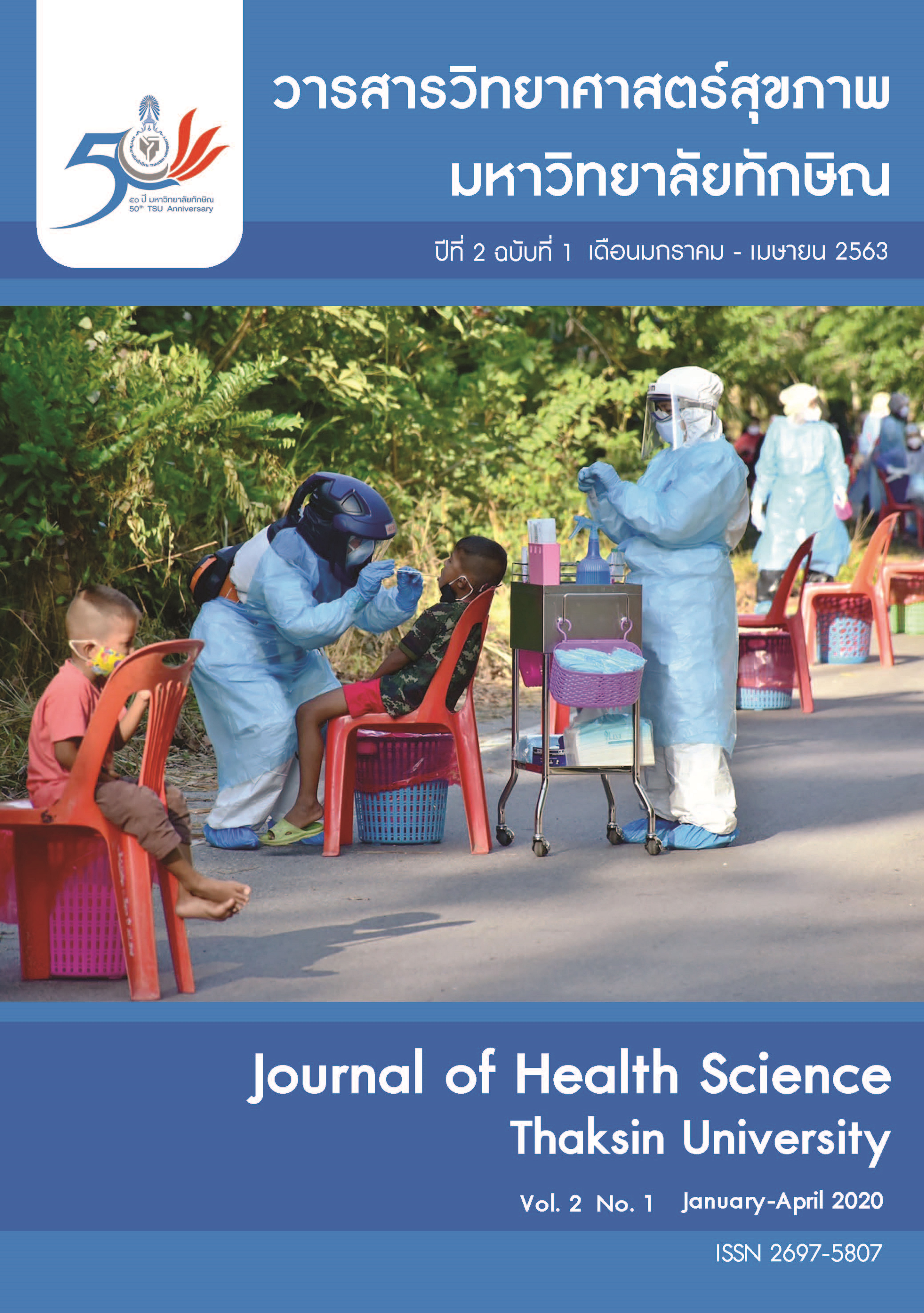Factors Associated with Cervical Cone Margin after Loop Electrosurgical Excision Procedure (LEEP) in Women with Cervical Intraepithelial Neoplasia at Uttaradit Hospital
Main Article Content
Abstract
This study retrospective cohort study was to investigate the factors associated with cervical cone margin after Loop Electrosurgical Excision Procedure (LEEP) in women with cervical intraepithelial neoplasia. The data were collected from medical records among 229 patients with cervical intraepithelial neoplasia after LEEP at Uttaradit Hospital during January 2015 to April 2019. Descriptive statistics and multiple logistic regression were used in this study. Results showed that the factors associated with cervical cone margin after LEEP were cervical cytology of SCCA (Adj. OR= 7.89; 95%CI: 2.73-16.87), grade of disease at invasive SCC (Adj. OR= 7.55; 95%CI: 1.81-27.42), glandular involvement (Adj. OR= 3.51; 95%CI: 1.90-6.21), size of disease at 2 quadrant (Adj. OR= 6.10; 95%CI: 2.66-16.32), 3 quadrant (Adj. OR= 6.78; 95%CI: 3.61-14.91), and 4 quadrant (Adj. OR= 9.56; 95%CI: 1.89-20.32). This study found that factors associated with cervical cone margin after LEEP were statistically significant with cervical cytology of SCCA, grade of disease at invasive SCC and glandular involvement on pathology and size of disease more than one quadrant in cervical of patient.
Article Details
References
Parkin DM, Pisani P, Ferlay J. Global cancer statistics. CA Cancer J Clin 1999; 49(1): 33–64.
Parkin DM, Bray F, Ferlay J, Pisani P. Global cancer statistics, 2002. CA Cancer J Clin 2005;55(2): 74–108.
Bray F, Jemal A, Grey N, Ferlay J, Forman D. Global cancer transitions according to the Human Development Index (2008–2030): a population-based study. Lancet Oncol 2012; 13(8): 790–801.
Bray F, Ferlay J, Soerjomataram I, Siegel RL, Torre LA, Jemal A. Global cancer statistics 2018: GLOBOCAN estimates of incidence and mortality worldwide for 36 cancers in 185 countries. CA Cancer J Clin 2018; 68(6): 394–424.
Torre LA, Bray F, Siegel RL, Ferlay J, Lortet-Tieulent J, Jemal A. Global cancer statistics, 2012. CA Cancer J Clin 2015; 65(2): 87–108.
Ferlay J, Colombet M, Soerjomataram I, Mathers C, Parkin DM, Piñeros M, et al. Estimating the global cancer incidence and mortality in 2018: GLOBOCAN sources and methods. Int J Cancer 2019 15; 144(8): 1941–53.
Walboomers JM, Jacobs MV, Manos MM, Bosch FX, Kummer JA, Shah KV, et al. Human papillomavirus is a necessary cause of invasive cervical cancer worldwide. J Pathol. 1999; 189(1): 12–9.
Herrero R, Murillo R. Cervical cancer. In: MJ Thun, MS Linet, JR Cerhan, CA Haiman, D, Schottenfeld eds. Cancer Epidemiology and Prevention. N Y Oxf Univ Press 2018: 925- 946.
Med Thai. Cervical cacer Screeing: Pap-Smear (Pap Smear and Pap test) [Internet]. Medthai. 2018 [cited 2019 Oct 24]. Available from: https://medthai.com/10.
Kietpeerakool C, Khunamornpong S, Srisomboon J, Siriaunkgul S, Suprasert P. Cervical intraepithelial neoplasia II-III with endocervical cone margin involvement after cervical loop conization: is there any predictor for residual disease? J Obstet Gynaecol Res 2007; 33(5): 660–4.
Melnikow J, McGahan C, Sawaya GF, Ehlen T, Coldman A. Cervical intraepithelial neoplasia outcomes after treatment: long-term follow-up from the British Columbia Cohort Study. J Natl Cancer Inst 2009; 101(10): 721–8.
Soutter WP, de Barros Lopes A, Fletcher A, Monaghan JM, Duncan ID, Paraskevaidis E, et al. Invasive cervical cancer after conservative therapy for cervical intraepithelial neoplasia. Lancet Lond Engl 1997; 349(9057): 978–80.
Cai H, Ma T, Che Y, Wang Y, Wang C, Yin G. Loop electrosurgical excision procedure followed by 5-aminolevulinic acid photodynamic therapy for cervical intraepithelial neoplasia, a report of six cases. Photodiagnosis Photodyn Ther 2020; 101650.
Fan Q, Tay SK, Shen K. [Loop electrosurgical excision procedure: a valuable method for the treatment of cervical intraepithelial neoplasia]. Zhonghua Fu Chan Ke Za Zhi 2001; 36(5): 271–4.
Kietpeerakool C, Srisomboon J, Khobjai A, Chandacham A, Tucksinsook U. Complications of loop electrosurgical excision procedure for cervical neoplasia: a prospective study. J Med Assoc Thail Chotmaihet Thangphaet 2006; 89(5): 583–7.
Baloglu A, Uysal D, Bezircioglu I, Bicer M, Inci A. Residual and recurrent disease rates following LEEP treatment in high-grade cervical intraepithelial lesions. Arch Gynecol Obstet 2010; 282(1): 69–73.
uealon P. Factors for predicted cone margin after excissional procedure for cervical cancer for cervical intraepithelial neoplasia in Roi Et Hospital. Roi Hosp J 2017; 4(1): 51–62.
Kietpeerakool C, Srisomboon J, Ratchusiri K. Clinicopathologic predictors of incomplete excision after loop electrosurgical excision for cervical preneoplasia. Asian Pac J. Cancer Prev 2005; 6(4): 481-4.
Kietpeerakool C, Khunamornpong S, Srisomboon J, Siriaunkgul S, Suprasert P. Cervical intraepithelial neoplasia II-III with endocervical cone margin involvement after cervical loop conization: is there any predictor for residual disease? J Obstet Gynaecol Res 2007; 33(5): 660–4.
Lu H, Chen Y, Ni J, Wan X, Lü W, Xie X. [Study on high risk factors associated with positive margin of cervix conization in patient with cervical intraepithelial neoplasia]. Zhonghua Fu Chan Ke Za Zhi 2009; 44(3): 200–3.
Ayhan A, Tuncer HA, Reyhan NH, Kuscu E, Dursun P. Risk factors for residual disease after cervical conization in patients with cervical intraepithelial neoplasia grades 2 and 3 and positive surgical margins. Eur J Obstet Gynecol Reprod Biol 2016; 201: 1–6.
Livasy CA, Maygarden SJ, Rajaratnam CT, Novotny DB. Predictors of recurrent dysplasia after a cervical loop electrocautery excision procedure for CIN-3: a study of margin, endocervical gland, and quadrant involvement. Mod Pathol Off J U S Can Acad Pathol Inc 1999; 12(3): 233–8.
Kietpeerakool C, Sukkawattananon W, Srisomboon J, Khunamornpong S, Siriaunkgul S, Nimmanhaeminda K. Factors predicting occult invasive carcinoma in women undergoing a ‘see and treat’approach. Asian Pac J Cancer Prev 2008; 9(2): 209-12.
Chaijindaratana S, Chaisuriyapan T. Prevalence and Risk Factor of Incomplete Cervical Excision in Chonburi Hospital. Thai J Obstet Gynaecol 2013; 1: 41–8.


